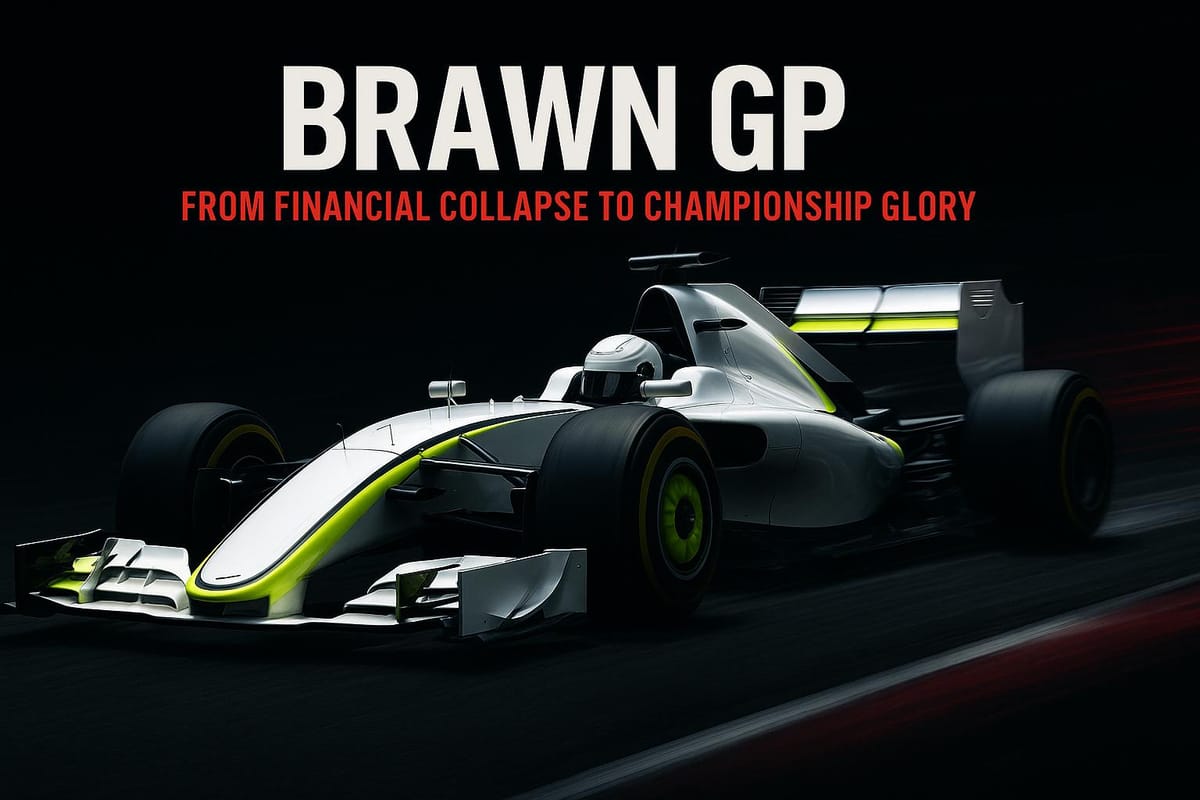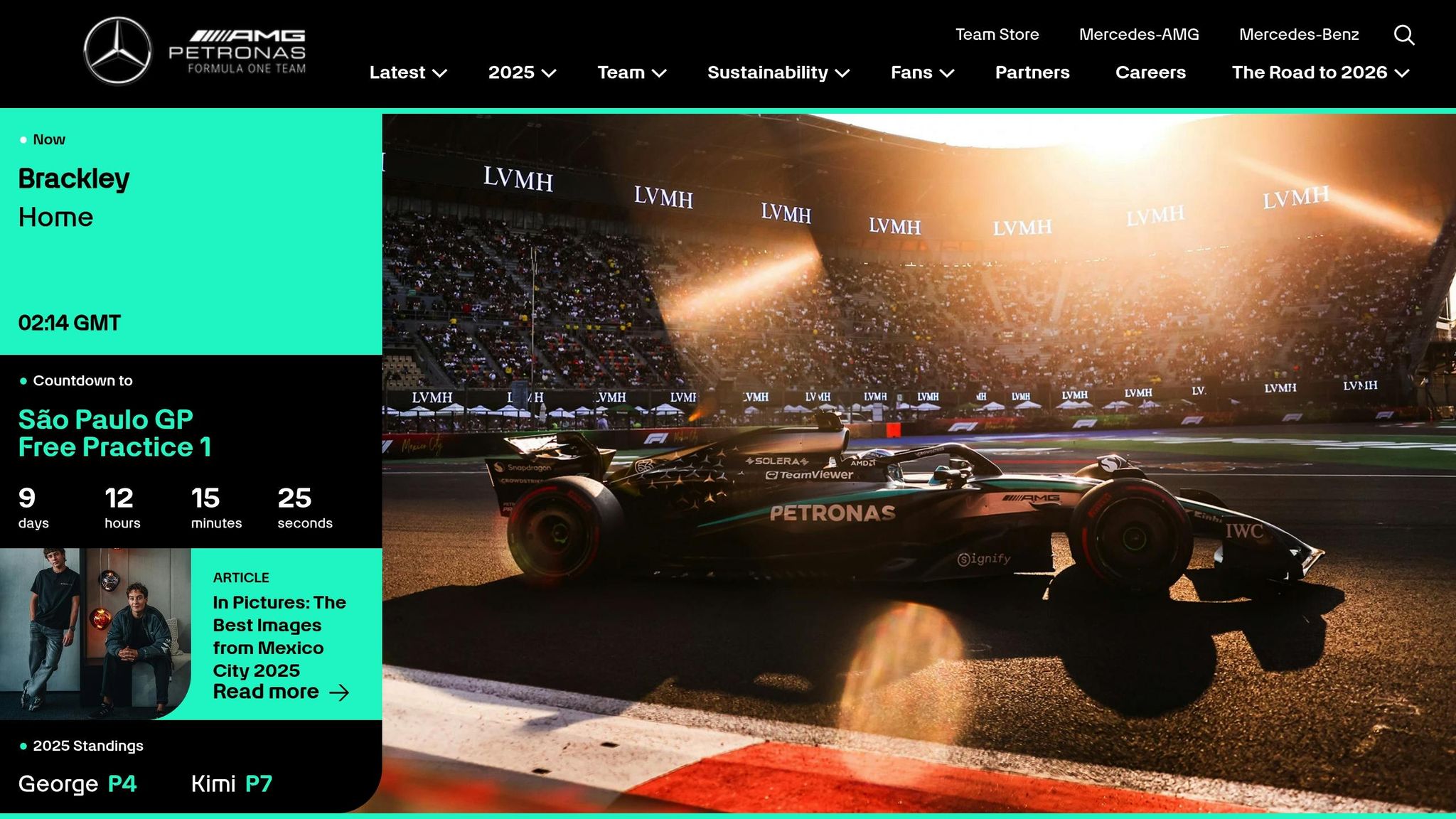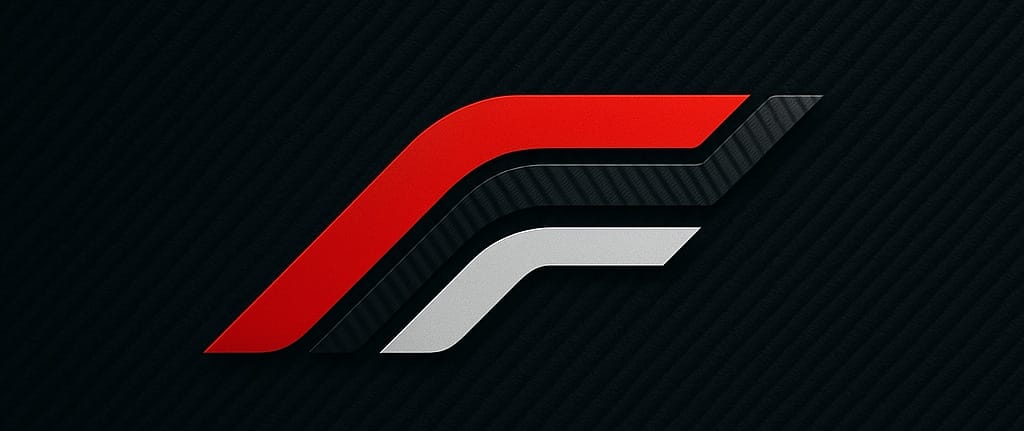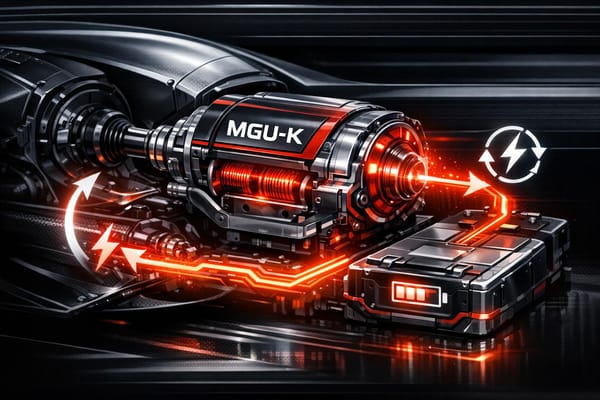Brawn GP: From Financial Collapse to Championship Glory
Explore how a struggling F1 team transformed into champions in just one season, defying odds through innovation and strategic genius.

Brawn GP's story is one of the most incredible in Formula One history. In 2009, they went from near extinction to winning both the Constructors' and Drivers' Championships in their debut - and only - season. Here's how they did it:
- Honda's Exit: Honda withdrew from F1 in late 2008 due to the financial crisis, leaving the team in limbo.
- Ross Brawn's Leadership: Ross Brawn bought the team for £1 ($1.50), secured a $100 million budget from Honda, and rebranded it as Brawn GP.
- Mercedes Engines: The team adapted their car to use Mercedes engines, ensuring competitiveness.
- Double Diffuser Innovation: A clever aerodynamic design gave them a performance edge, despite protests from rivals.
- 2009 Season Success: Jenson Button won 6 of the first 7 races, and the team claimed 8 wins overall, securing both titles.
Brawn GP's triumph was a combination of quick decisions, resourcefulness, and technical ingenuity. Their legacy lives on, as the team evolved into Mercedes AMG F1, which has since dominated the sport.
The Incredible Story of Brawn GP: F1's £1 Team That Made History
Honda's Withdrawal and the Formation of Brawn GP
The transition from Honda Racing F1 to Brawn GP happened at lightning speed, reshaping the team in record time. When Honda announced its exit in December 2008, it triggered a chain of events that led to the creation of one of Formula One's most remarkable teams. Here's how it all unfolded.
The December 2008 Honda Announcement
In December 2008, Honda shocked the Formula One world with its abrupt decision to withdraw from the sport. The Japanese manufacturer cited the global financial crisis as the driving factor behind the move. This announcement came at a terrible time for the team, which was already gearing up for the 2009 season. The decision left around 700 employees, including drivers Jenson Button and Rubens Barrichello, in limbo. The team's future was uncertain, and development for the upcoming season came to a grinding halt. Tragically, about half of the workforce lost their jobs, highlighting the devastating human toll of the financial crisis.
The £1/$1.50 Buyout Deal
Amid the turmoil, Ross Brawn stepped in with a bold plan to save the team, turning a dire situation into a new beginning. Working alongside commercial manager Nick Fry, Brawn orchestrated a buyout for the symbolic price of £1 (roughly $1.50 USD). While the price tag may have been nominal, the deal itself was anything but simple. Finalized in March 2009, it required negotiations and strategic planning to ensure the team could continue. Brawn's experience as a championship-winning engineer with Benetton and Ferrari played a key role in securing trust and stability. Additionally, the FIA allowed the new team to take over Honda's entry slot without paying the usual fee, giving Brawn GP a critical lifeline.
With the ownership settled, the team faced another major hurdle: finding a new engine supplier.
Securing Mercedes Engines
In the midst of financial and technical challenges, Brawn GP managed to secure Mercedes engines for the 2009 season, ensuring they had a reliable and competitive power unit. However, the car had originally been designed for Honda engines, so the engineering team had to move quickly to adapt it for the new Mercedes units. Despite the tight timeline, they successfully completed the necessary modifications, testing, and homologation just in time for the first race of the season. This partnership not only resolved an immediate technical issue but also laid the groundwork for Mercedes' eventual return as a full factory team.
From Honda's sudden departure to the rapid formation of Brawn GP, the team overcame enormous obstacles. With financial backing, a strong engine, and a resilient spirit, they were ready to take on the 2009 season - and what came next would defy all expectations.
Technical Development: The Double Diffuser
Securing Mercedes engines was a significant step forward for Brawn GP, but their real game-changer came from an aerodynamic innovation that set the tone for their championship-winning season: the double diffuser.
2009 Regulation Changes and Their Impact
After acquiring engines, Brawn GP shifted its focus to redesigning its car to comply with the new regulations introduced for the 2009 Formula One season. These changes brought a shake-up in car design. The FIA introduced slick tires, banned traction control systems, and enforced aerodynamic adjustments, including smaller rear wings to reduce downforce. While many established teams struggled to adapt quickly to the new rules, Brawn GP saw an opportunity. Under the leadership of Ross Brawn and aerodynamics expert Loic Bigois, the team took advantage of ambiguities in the regulations to develop a competitive edge. Their ability to interpret these changes creatively allowed them to exploit the new rules while others lagged behind.
How the Double Diffuser Worked
The double diffuser was a clever design tweak that gave Brawn GP a critical advantage in generating downforce. In a typical setup, a diffuser channels airflow from beneath the car to create downforce. The double diffuser, however, introduced a secondary channel that worked alongside the primary one. This dual-channel system directed airflow more efficiently, significantly boosting rear downforce and improving the car’s handling. Paired with the new slick tires and reduced aerodynamic setups, this design helped offset the downforce lost due to the regulation changes, enhancing grip and overall performance. Brawn GP’s engineers found a way to stay within the rules while extracting maximum performance. This extra downforce was instrumental in turning their technical advantage into race victories, though it quickly attracted the attention - and protests - of rival teams.
Competitors' Reactions and Challenges
As Brawn GP’s double diffuser began to dominate early testing and races, competitors took notice - and not in a good way. Several teams questioned the legality of the design, leading to protests and formal reviews by the FIA. After thorough investigations, the FIA confirmed the double diffuser complied with the regulations, allowing Brawn GP to keep using it. While teams like Williams and Toyota had their own versions from the start of the season, their designs didn’t match the effectiveness of Brawn GP’s. Other teams scrambled to introduce their own versions mid-season, but these efforts fell short.
| Team | Double Diffuser Introduction | Championship Outcome |
|---|---|---|
| Brawn GP | Season start (March 2009) | Won both titles |
| Toyota | Season start | No titles |
| Williams | Season start | No titles |
| Other teams | Mid-season (after FIA ruling) | No titles |
Brawn GP’s version of the double diffuser stood out as the most effective. This innovation became a cornerstone of their historic 2009 season. With 8 wins out of 17 races, the team achieved a 47.1% win rate and an 88.2% podium rate. These results helped them secure 172 points in the Constructors' Championship, clinching both the Drivers' and Constructors' titles in their one and only season. The controversy surrounding the double diffuser and its eventual validation highlighted the importance of technical ingenuity and strategic rule interpretation in Formula One. It was a testament to how a young team could achieve extraordinary success through bold engineering choices and sharp thinking.
The 2009 Season: Success and Challenges
The 2009 Formula One season for Brawn GP was nothing short of extraordinary. It unfolded in three distinct chapters: an impressive start that turned heads, a mid-season period filled with hurdles, and a triumphant conclusion that etched their name into the sport's history books.
Early Season Success
Brawn GP made a jaw-dropping debut at the Australian Grand Prix on March 29, 2009. They locked out the front row in qualifying and delivered a 1-2 finish in the race, with Jenson Button taking the win and Rubens Barrichello following in second. This performance set the tone for their early dominance. Armed with the innovative double diffuser, Button claimed six victories in the first seven races, including standout performances in Malaysia, Bahrain, Spain, Monaco, and Turkey. By the end of this stretch, Button had built a commanding lead in the Drivers' Championship, while Barrichello's consistent podium finishes and the team's four 1-2 results solidified their momentum. But the season wasn’t without its twists and turns.
Mid-Season Challenges
As the European summer rolled in, Brawn GP faced a host of challenges. Financial limitations began to bite; despite starting the season with a $100 million budget from Honda, funds were stretched thin for mid-season upgrades. On top of that, the BGP 001 car struggled with tire temperature management on hotter tracks, eroding its early performance advantage. Meanwhile, rival teams like Red Bull Racing were catching up fast, developing their own double diffuser solutions after initial protests against the design were dismissed. This increased competition slowed Button’s winning streak as the fight for supremacy grew tighter.
Securing the Championship
Even with these hurdles, Brawn GP held their ground through smart strategy and calculated decisions. Instead of chasing expensive mid-season upgrades, the team focused on refining their existing strengths. Ross Brawn’s steady leadership proved invaluable during the tense title fight. Key victories by Barrichello in Valencia and Monza added vital points to the Constructors' tally, while Button’s consistent finishes ensured his lead in the Drivers' standings remained intact. The pivotal moment came at the Brazilian Grand Prix on October 18, 2009, where Button’s masterful drive secured the Drivers' Championship with one race to spare.
Brawn GP achieved what no other team has done: they won both the Drivers’ and Constructors’ Championships in their debut - and only - season, an unparalleled 100% championship success rate.
| Championship Metric | Brawn GP Performance | Historical Context |
|---|---|---|
| Races Won | 8 out of 17 (47.1%) | Highest win rate for a debut team |
| Podium Rate | 15 out of 34 entries (88.2%) | Outstanding consistency |
| Championship Titles | 2 (Drivers' & Constructors') | Only team to win both in its debut season |
| Total Points | 172 | Secured a comfortable lead |
The 2009 season was a showcase of what can be achieved through technical ingenuity, sharp leadership, and resourceful management. Brawn GP’s incredible journey stands as one of the most inspiring stories in Formula One, proving that even a small team with big ideas can rise to the top and make history.
Legacy and Impact of Brawn GP
Brawn GP's single season in Formula One was nothing short of extraordinary. Their story is one of strategic brilliance and resilience, leaving a lasting mark on the sport and setting the stage for future dominance.
Transition to Mercedes AMG F1

On November 16, 2009, Mercedes-Benz, in collaboration with Aabar Investments, acquired a 75.1% stake in Brawn GP. This marked the beginning of one of Formula One's most dominant periods. Mercedes saw immense value in the winning culture that Brawn GP had cultivated, choosing to retain key figures like Ross Brawn and other crucial technical staff. By doing so, they ensured the team's championship-winning expertise remained intact.
This continuity proved pivotal. The technical ingenuity that had powered Brawn GP's success became the backbone of Mercedes AMG F1's dominance. Between 2014 and 2021, the team secured eight consecutive Constructors' Championships and seven Drivers' Championships. The innovative mindset and problem-solving approach that defined Brawn GP seamlessly transitioned into the Mercedes era, cementing their place as a powerhouse in Formula One.
Lessons for Teams in Adversity
Brawn GP's journey is a masterclass in overcoming adversity with resourcefulness rather than relying solely on financial muscle. Faced with Honda's abrupt withdrawal, the team acted swiftly, orchestrating a management buyout and securing critical partnerships to stay afloat. This quick thinking preserved their technical assets and kept team morale high.
Moreover, Brawn GP focused on maximizing their existing strengths. Their clever use of the double diffuser - a groundbreaking innovation under the 2009 technical regulations - gave them a competitive edge without requiring expensive mid-season upgrades. This approach highlights the importance of talent retention and operational efficiency, offering valuable lessons for teams navigating crises.
Brawn GP in F1 History
Brawn GP's meteoric rise remains unique in Formula One. Winning both the Drivers' and Constructors' Championships in their sole season gave them a 100% success rate - an achievement unmatched in the sport's history. Their innovative interpretation of the 2009 technical regulations, particularly the double diffuser, not only secured their titles but also led to regulatory changes by the FIA. This ripple effect reshaped the sport's technical landscape far beyond their championship year.
| Historic Achievement | Brawn GP | Comparable F1 Moments |
|---|---|---|
| Championship Success | 100% (1 season, 2 titles) | Unmatched in F1 history |
| Regulatory Impact | Double diffuser controversy | – |
| Team Transformation | Honda → Brawn → Mercedes | Tyrrell → BAR evolution |
| Crisis Management | From financial collapse to titles | – |
Brawn GP's legacy is not just about their historic wins but also their technical and strategic contributions, which continue to influence Formula One today. For deeper insights into moments like these, F1 Briefing offers a closer look at how Brawn GP's story continues to shape the sport.
Conclusion: The Story of Brawn GP
Brawn GP's journey from the brink of collapse to championship triumph is motorsport's ultimate underdog tale. Their brief but unforgettable stint in Formula One offers timeless lessons and a lasting legacy.
Key Lessons from Brawn GP
Brawn GP's story is a masterclass in turning adversity into opportunity. When Honda pulled out, Ross Brawn acted swiftly - securing a buyout, arranging a budget, and locking in Mercedes engines. His quick thinking and decisive leadership laid the groundwork for success.
Innovation played a pivotal role. The double diffuser design was a game-changer, proving how a fresh perspective on the rules can deliver a competitive edge when others stick to the norm.
Equally important was the team's unity under immense pressure. Limited finances and scarce resources didn’t hold them back. Instead, they focused their efforts, making the most of every opportunity. Their championship win was a testament to what a united and determined team can achieve.
Why Brawn GP's Story Still Matters
The lessons from Brawn GP's season go far beyond 2009. Their success remains a beacon of hope in a sport often dominated by big budgets. They showed that smart strategy and technical ingenuity can level the playing field.
Their impact on modern Formula One is undeniable. When Mercedes acquired the team, they inherited not just infrastructure but also a winning culture - a foundation that fueled years of dominance.
For teams facing challenges, Brawn GP's approach is a blueprint. They leaned on their strengths instead of chasing expensive solutions, proving that resourcefulness and focus can lead to extraordinary outcomes.
The double diffuser innovation also serves as a reminder of how regulation changes can shake up the grid. Brawn GP seized the moment, showing that every rule tweak is an opportunity for those willing to think differently.
The numbers say it all: one team, one season, two championships, and a perfect success rate. But beyond the stats, Brawn GP's story is about more than trophies. It’s proof that with the right leadership, creativity, and determination, even the most daunting challenges can be overcome. Their legacy continues to inspire, reminding us that anything is possible.
FAQs
How did Ross Brawn turn a near-bankrupt F1 team into a championship winner in just one season?
Ross Brawn’s achievement with Brawn GP stands as a testament to sharp strategy and well-timed decisions. When Honda announced its withdrawal from Formula 1 in late 2008, Brawn spearheaded a management buyout, transforming the team into Brawn GP. Despite limited resources, he zeroed in on optimizing the car’s performance, particularly through the use of the groundbreaking double diffuser design. This innovation provided a key aerodynamic edge over the competition.
To complement the car’s design, Brawn secured competitive engines from Mercedes, ensuring both reliability and strong performance on the track. With Jenson Button and Rubens Barrichello behind the wheel, the team leveraged their early-season dominance to secure both the Drivers’ and Constructors’ Championships in 2009. This incredible feat remains one of Formula 1’s most unforgettable success stories.
How did the double diffuser contribute to Brawn GP's championship win, and why was it controversial?
The double diffuser was a game-changing aerodynamic design that gave Brawn GP a massive edge during their debut Formula 1 season in 2009. By interpreting the sport's technical rules in a clever way, Brawn GP's engineers developed a diffuser that enhanced airflow beneath the car. This design created more downforce, allowing for better cornering speeds while keeping straight-line performance intact - a rare combination in F1.
Not surprisingly, this innovation stirred up plenty of controversy. Rival teams claimed the design took advantage of a loophole in the regulations. Despite protests, the FIA reviewed the design and ruled it legal. This decision allowed Brawn GP to retain their advantage, ultimately leading them to clinch both the Drivers' and Constructors' Championships in their very first season.
How did Brawn GP's 2009 championship victory shape its evolution into Mercedes AMG F1?
Brawn GP's incredible debut season in 2009 didn’t just earn them a championship - it completely altered the team’s trajectory. Their overwhelming success caught the eye of Mercedes-Benz, which purchased the team later that year. This acquisition led to the rebranding of the team as Mercedes GP, marking Mercedes's official return to Formula 1 as a works team and setting the stage for their future dominance.
The shift from Brawn GP to Mercedes AMG F1 stands as one of the most impressive transformations in Formula 1 history. The team went on to set new benchmarks in the modern era of racing, establishing themselves as a powerhouse in the sport.




